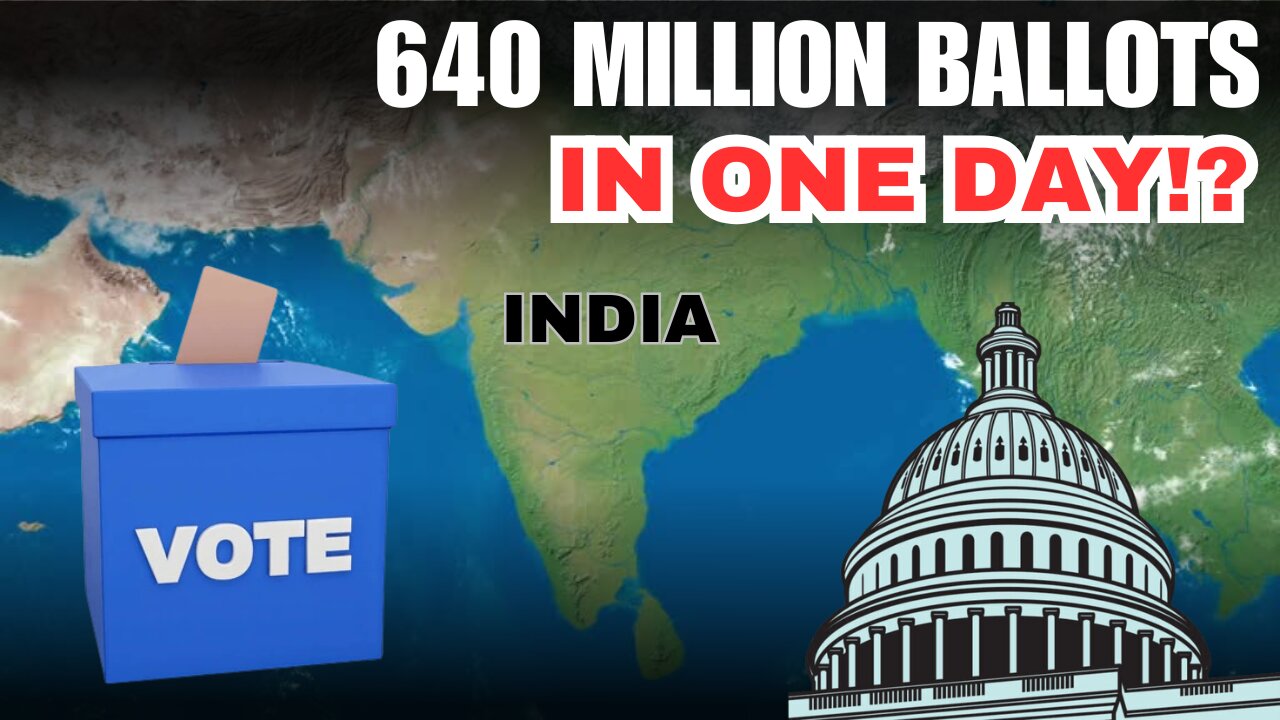Premium Only Content

India Counted 640 Million Votes In One Day!?
ChromoCast #4
**I realized I didn't clarify that in the US the senate and house determine the NUMBER of electors they are not the electors themselves.
Intro:
-Good opportunity to discuss the philosophical differences between the function of the two systems.
- 640 Million votes in one day and were not supposed to be sketched out by the fact that there are still 300k votes left to be counted half a month after the election?
Discussion
- Outcome and Purpose:
- India’s Electoral College prioritizes proportional representation to uphold the principle of democracy in a parliamentary system.
- The U.S. Electoral College emphasizes federalism and state sovereignty to ensure geographical diversity and prevent the dominance of densely populated urban areas.
1. The Irony of Delayed Results
- Elon Musk -"India counts 640 million votes in one day, while parts of the U.S. struggle to count a fraction of that weeks later."*
- Why do these systems work so differently, and what do these differences tell us about how democracy is structured in each country?
- Are these delays just inefficiency, or are they reflective of deeper structural and cultural priorities?
. Structural Similarities and Practical Differences
- Both systems aim to balance representation with democratic ideals.
- Both rely on intermediary bodies (Electoral Colleges) for electing their Presidents.
- India: Prioritizes efficiency: centralized election authority (Election Commission of India) ensures streamlined processes.
- U.S.: Prioritizes Soveriegnty: Decentralized processes mean each state controls its own election systems, leading to variability in speed, accuracy, and procedures.
2. Philosophical Differences Between the Systems
- India: Reflects a parliamentary democracy where proportional representation aligns with its population’s diversity.
- Votes in India's Electoral College are weighted by population, meaning more populous states and regions have greater influence.
- This system is more directly representative of the overall population, as it ensures areas with larger populations have a proportionally larger say in electing the President.
- However, this emphasis on population density offers less protection to smaller or less populous states and communities, increasing the risk of "rule by the majority."
- U.S.: Balances regional diversity in a federal system, emphasizing state sovereignty over pure population-based representation.
- The U.S. Electoral College gives states a mix of population-based electors (House representation) and state-based electors (Senate representation).
- Smaller states benefit from disproportionate representation, ensuring rural and less populous areas maintain significant influence in presidential elections.
- This design creates a hedge against majority rule, where the interests of urban centers could otherwise overshadow rural communities.
- India’s System:
- Philosophical trade-offs:
- India focuses on speed and centralization in its vote-counting process, prioritizing efficiency and inclusivity in one streamlined system.
- Provides a more accurate reflection of the population's overall will.
- Sacrifices the ability to protect less populous states or regions from being dominated by majority populations.
- U.S. System:
- The U.S. system prioritizes checks and balances through federalism, which can lead to localized autonomy but slower results.
- Ensures regional diversity and minority protection by amplifying the voice of rural states.
- Can result in outcomes where the national popular vote does not align with the elected President, reflecting a trade-off between federalist principles and pure democratic representation.
4. Why Delays in the U.S. Matter
-Broader challenges: effects of COVID election changes that were made permanent in many states, decentralized systems (non-uniform changes to election procedures state-by-state), mail-in ballots, and litigation.
-Are delays like these caused by changing and opaque election procedures in some states eroding trust in the system, especially when juxtaposed against a country like India managing over half a billion votes in one day?
5. Broader Implications and Takeaways
- India’s system is more efficient and representative of population size
- The U.S. system is deliberately slower and more complex, offering protections for minority voices ( rural communities)
Should the U.S. adopt a national standard that state election boards must meet for greater efficiency, or does the largely unregulated decentralized approach ultimately protect against national-level corruption and authoritarianism?
-
 4:45:15
4:45:15
RalliedLIVE
9 hours ago $1.76 earnedWarzone Domination w/ Ral
56.7K -
 1:10:17
1:10:17
Sarah Westall
11 hours agoWorld Leaders Increasingly Display Panic Behavior as Economic Change Accelerates w/ Andy Schectman
85K16 -
 59:54
59:54
Motherland Casino
8 hours ago $1.96 earnedScar x Ayanna
35.6K6 -
 41:57
41:57
BonginoReport
13 hours agoProtecting Kids From WOKE Ideology in School (Ep. 35) - Nightly Scroll with Hayley Caronia -04/25/25
124K50 -
 7:17:12
7:17:12
SpartakusLIVE
11 hours agoFriday Night HYPE w/ #1 All-American Solo NUKE Hero
30.4K -
 1:15:07
1:15:07
Kim Iversen
1 day agoThe Left Is Dead — What And Who Will Rise From the Ashes?
106K102 -
 2:06:17
2:06:17
Joker Effect
8 hours agoYOU DON'T UNDERSTAND FREEDOM OF SPEECH IF THIS MAKES YOU MAD!
16.3K1 -
 1:45:26
1:45:26
vivafrei
15 hours agoSantos Sentenced to 87 MONTHS! Corrupt Judges ARRESTED! Some Canada Stuff & MORE!
146K102 -
 4:34:03
4:34:03
Nerdrotic
14 hours ago $33.73 earnedStar Wars GRAPED? Hollywood In Freefall, Silver Surfer is a MAN! | Friday Night Tights 351
104K30 -
 1:33:35
1:33:35
Keepslidin
10 hours ago $1.03 earned$5000 START | ROAD TO 100K | Mother.land
30.9K2